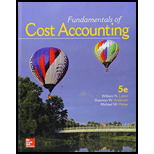
Fundamentals of Cost Accounting
5th Edition
ISBN: 9781259565403
Author: William N. Lanen Professor, Shannon Anderson Associate Professor, Michael W Maher
Publisher: McGraw-Hill Education
expand_more
expand_more
format_list_bulleted
Textbook Question
Chapter 1, Problem 4RQ
Distinguish among the value chain, the supply chain, and the distribution chain.
Expert Solution & Answer
Trending nowThis is a popular solution!

Students have asked these similar questions
Please add on to it and expand please.
Please provide the accurate answer to this general accounting problem using appropriate methods.
None
Chapter 1 Solutions
Fundamentals of Cost Accounting
Ch. 1 - Explain why it is important to consider the...Ch. 1 - Explain the differences between financial...Ch. 1 - Place the letter of the appropriate accounting...Ch. 1 - Distinguish among the value chain, the supply...Ch. 1 - Who are the customers of cost accounting?Ch. 1 - How can cost accounting information together with...Ch. 1 - Prob. 7RQCh. 1 - Does the passage of Sarbanes-Oxley mean that codes...Ch. 1 - Prob. 9CADQCh. 1 - Prob. 10CADQ
Ch. 1 - Prob. 11CADQCh. 1 - Its not the job of accounting to determine...Ch. 1 - Prob. 13CADQCh. 1 - How would cost accounting information help...Ch. 1 - Airlines are well known for using complex pricing...Ch. 1 - Nabisco (a unit of Kraft Foods) makes a variety of...Ch. 1 - What potential conflicts might arise between...Ch. 1 - Refer to the Business Application discussion of...Ch. 1 - Prob. 19CADQCh. 1 - Why does a cost accountant need to be familiar...Ch. 1 - Will studying cost accounting increase the chances...Ch. 1 - Prob. 22CADQCh. 1 - Value Chain and Classification of Costs Apple...Ch. 1 - Prob. 24ECh. 1 - Accounting Systems McDonalds is a major company in...Ch. 1 - Accounting Systems Ford Motor Company manufactures...Ch. 1 - Cost Data for Managerial Purposes As an analyst at...Ch. 1 - Prob. 28ECh. 1 - Prob. 29ECh. 1 - Cost Data for Managerial Purposes Refer to the...Ch. 1 - Prob. 31ECh. 1 - Trends in Cost Accounting Required For each cost...Ch. 1 - Prob. 33ECh. 1 - Prob. 34ECh. 1 - Prob. 35ECh. 1 - Prob. 36PCh. 1 - Cost Data for Managerial Purposes Imperial Devices...Ch. 1 - Cost Data for Managerial Purposes You have been...Ch. 1 - Prob. 39PCh. 1 - Cost Data for Managerial Purposes Campus Package...Ch. 1 - Cost Data for Managerial Purposes KC Services...Ch. 1 - Cost Data for Managerial Purposes B-You is a...Ch. 1 - Cost Data for Managerial Purposes Toms Tax...Ch. 1 - Cost Data for Managerial PurposesBudgeting Refer...Ch. 1 - Cost Data for Managerial PurposesBudgeting Refer...Ch. 1 - Cost Data for Managerial PurposesFinding Unknowns...Ch. 1 - Identifying Unethical Actions (Appendix) The...Ch. 1 - Miller Cereals is a small milling company that...Ch. 1 - Before Miller Cereals can introduce the new...Ch. 1 - The following story is true except that all names...
Knowledge Booster
Learn more about
Need a deep-dive on the concept behind this application? Look no further. Learn more about this topic, accounting and related others by exploring similar questions and additional content below.Similar questions
- Please provide the solution to this general accounting question with accurate financial calculations.arrow_forwardCan you solve this general accounting problem using accurate calculation methods?arrow_forwardI am looking for help with this general accounting question using proper accounting standards.arrow_forward
- Can you solve this general accounting question with the appropriate accounting analysis techniques?arrow_forwardPlease provide the answer to this general accounting question with proper steps.arrow_forwardCan you help me solve this general accounting question using valid accounting techniques?arrow_forward
- I am trying to find the accurate solution to this general accounting problem with the correct explanation.arrow_forwardCan you explain this general accounting question using accurate calculation methods?arrow_forwardI need help with this general accounting problem using proper accounting guidelines.arrow_forward
arrow_back_ios
SEE MORE QUESTIONS
arrow_forward_ios
Recommended textbooks for you
- Principles of Accounting Volume 2AccountingISBN:9781947172609Author:OpenStaxPublisher:OpenStax College
 Managerial AccountingAccountingISBN:9781337912020Author:Carl Warren, Ph.d. Cma William B. TaylerPublisher:South-Western College Pub
Managerial AccountingAccountingISBN:9781337912020Author:Carl Warren, Ph.d. Cma William B. TaylerPublisher:South-Western College Pub Managerial Accounting: The Cornerstone of Busines...AccountingISBN:9781337115773Author:Maryanne M. Mowen, Don R. Hansen, Dan L. HeitgerPublisher:Cengage Learning
Managerial Accounting: The Cornerstone of Busines...AccountingISBN:9781337115773Author:Maryanne M. Mowen, Don R. Hansen, Dan L. HeitgerPublisher:Cengage Learning  Cornerstones of Cost Management (Cornerstones Ser...AccountingISBN:9781305970663Author:Don R. Hansen, Maryanne M. MowenPublisher:Cengage Learning
Cornerstones of Cost Management (Cornerstones Ser...AccountingISBN:9781305970663Author:Don R. Hansen, Maryanne M. MowenPublisher:Cengage Learning Intermediate Accounting: Reporting And AnalysisAccountingISBN:9781337788281Author:James M. Wahlen, Jefferson P. Jones, Donald PagachPublisher:Cengage Learning
Intermediate Accounting: Reporting And AnalysisAccountingISBN:9781337788281Author:James M. Wahlen, Jefferson P. Jones, Donald PagachPublisher:Cengage Learning

Principles of Accounting Volume 2
Accounting
ISBN:9781947172609
Author:OpenStax
Publisher:OpenStax College

Managerial Accounting
Accounting
ISBN:9781337912020
Author:Carl Warren, Ph.d. Cma William B. Tayler
Publisher:South-Western College Pub

Managerial Accounting: The Cornerstone of Busines...
Accounting
ISBN:9781337115773
Author:Maryanne M. Mowen, Don R. Hansen, Dan L. Heitger
Publisher:Cengage Learning

Cornerstones of Cost Management (Cornerstones Ser...
Accounting
ISBN:9781305970663
Author:Don R. Hansen, Maryanne M. Mowen
Publisher:Cengage Learning

Intermediate Accounting: Reporting And Analysis
Accounting
ISBN:9781337788281
Author:James M. Wahlen, Jefferson P. Jones, Donald Pagach
Publisher:Cengage Learning
alue Chain Analysis EXPLAINED | B2U | Business To You; Author: Business To You;https://www.youtube.com/watch?v=SI5lYaZaUlg;License: Standard Youtube License